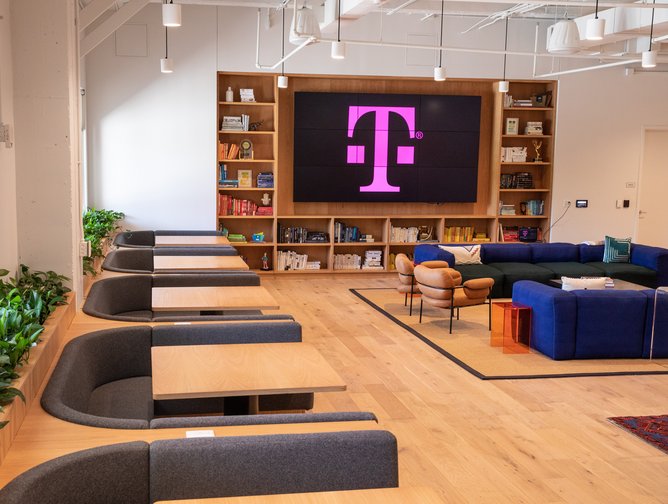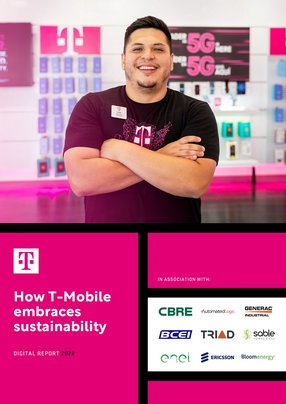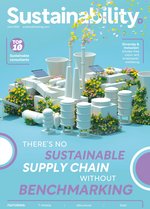The United States telco disrupter T-Mobile saw tremendous growth even before its merger with Sprint in 2020 and, according to Chad Wilkerson, Director of Sustainability and Infrastructure Sourcing for T-Mobile, an increased commitment to sustainability was another aspect of the company’s mission to do good.
The idea of the “Un-carrier” first launched in 2013, aiming to make wireless communications simpler by eliminating pain points such as data overages and surprise fees. Although this is an integral part of T-Mobile’s customer strategy, customer retention goes hand-in-hand with robust productivity within the company ‒ as demonstrated by its target-setting aims.
“I would say our approach to environmental sustainability has been growing alongside the company,” says Wilkerson. “Within that culture, there are pockets of intrinsic goodness, with employees that were already doing environmental initiatives in one form or another. And so really, it was going out and seeing all these different groups of people doing the right thing and finding the thread that helped us as a company to kind of grow from there.”
Establishing sustainability as part of the corporate culture means ingraining each environmental target in every aspect of the company's business processes and decision making.
“Our ultimate goal is for it to be fully embedded in processes, as part of everything we're doing as a company. Every business decision would start with the question of ‘what impact does this have on our emissions?’ or ‘what is the sustainability impact of this decision?’,” he says.
Achieving RE100
In 2018, T-Mobile set an industry first by joining the RE100 pledge and committing to sourcing 100% of its total electricity usage from renewable energy by the end of 2021.
“I think joining RE100 really showed the commitment and the seriousness with which we were taking these sorts of issues,” says Wilkerson. “We wanted to source our electricity from 100% renewable sources and put a stake in the ground by doing so.”
At the end of 2021, T-Mobile was able to meet this goal, even after a historic merger that significantly expanded its electricity needs. In addition, the company has established a standard of transparency in its robust reporting.
Aligning SBTis with corporate culture
In 2019, T-Mobile set an aspirational emission intensity target to reduce Scope 1 and Scope 2 GHG emissions by 95% and Scope 3 GHG emissions 15% per customer by 2025. T-Mobile was also one of the first 100 companies to have these goals approved by the Science Based Targets Initiative (SBTi).
Further to this, the company has made some of the most advanced progress in approaching its emission reduction goals, bringing home several prestigious pieces of evidence to support this claim ‒ such as being part of the CDP’s A List for Climate Change T-Mobile was also recently recognised as an exemplary Green Partner by the EPA, ranking #3 just behind Microsoft and Google on the Top 100 list of companies leading the way in their use of renewable power.
According to Wilkerson, the SBTi has a rigorous process and set of guidelines that primarily help to ensure that the goals being set align with companies’ actual impact, such as the volume of emissions they are producing.
“You see more and more companies align to SBTi standards – especially with the new guidelines coming out last year in which SBTi and other organisations are starting to define parameters around claiming net-zero,” says Wilkerson. “So, more and more companies are moving towards adopting science-based targets to ensure they have increased rigour around their goals.”
At that time, the criteria established surrounded the collective global aim to meet the two degrees mark, meant to restrict global warming to within two degrees above pre-industrial levels.
“T-Mobile set several emission reduction goals: reducing scope 1 and 2 emissions by 95%; and reducing scope 3 emissions by 15% per customer by 2025,” Wilkerson explains.
“Our targets received third-party validation and insight, which helped us evolve them by working with SBTi and CDP. By the end of 2021, we not only achieved but beat these targets four years ahead of schedule.”
Wilkerson believes more and more companies will start taking steps to meaningfully reduce their emissions across their operations and ensure transparency with investors, governments and customers about their efforts and progress.
Procurement and sustainability
To maximise its efforts, T-Mobile has established a set of guidelines in the handling of its operations, including design choices that can bring more efficiency to its energy usage. This extends to its supply chain group as well, from smaller things like minimising empty space on trucks as they're leaving the warehouse, to fuel usage and having fewer equipment truck runs.
“We partner with an outside agency that helps us to evaluate our suppliers. Every time a contract goes through, there's a third-party risk group that's able to access that information. Our sourcing managers are able to access that information and it really allows them to evaluate a supplier across all aspects of the ESG spectrum. We're comparing suppliers on the front end who have the values that match those of our company,” says Wilkerson.
“There's a series of questions that are embedded within the RFPs, allowing us to ask questions and get a good feel for what suppliers deem important or how they're performing. Going back to the self-assessment questionnaires through that third-party service actually then allows us to calculate a score for suppliers that offers us insights. We get an extensive report on each supplier that allows us to determine areas to focus on and it becomes a long-term partnership with them.”
The company also expects these partners to improve their scores as time goes on.
“Because, of course, their scope one and two emissions are our scope three emissions. And that's one of the items that we're focusing on – if it helps them improve, it helps us improve,” he says. “It's not just at the beginning of a relationship. It's an ongoing collaborative effort that allows us to see their progress each year. Our Supplier Code of Conduct includes language that helps set expectations for what we're wanting to see from our supply chain.”
This is also part of the job of the procurement and sustainability team: meeting with these suppliers directly to discuss the goals, best practices, and experiences in setting science-based targets.
“At this point, the department for sustainability and infrastructure sourcing covers a variety of items, with energy as one area of focus, for example,” says Wilkerson.
“Part of the strategy is that it is within procurement, which actually offers us a seat at the table to influence everything going on across company operations. It also allows us to work directly with our own category managers who are able to offer expert insights and work alongside procurement tenants,” says Wilkerson.
“We can share guidelines or frameworks we're going to operate in with our suppliers. Doing so really allows us to extend beyond just what our company is doing, instead actually having an influence on what other companies operating in the wireless industry are doing and the impact throughout the value chain.”
The company also tracks its facility’s life cycle carefully, identifying solutions when something needs to be decommissioned.
“We actually have several partners that help us decommission those sites. The materials are recycled or reused, or in some cases, we just ensure that we don't have a bunch of it going to municipal waste. We're reclaiming and utilising as much of that as possible,” Wilkerson says. “We actually are part of a working group with GSMA so we can take a more circular approach.”
T-Mobile and its energy efficiency efforts
As a tech company, energy usage has always been a top concern for T-Mobile when it comes to its overall sustainability efforts.
“T-Mobile uses a lot of energy,” says Wilkerson. “Even though we're going to be talking about renewable energy, energy efficiency is also part of that programme."
Wilkerson here refers to a classic saying: “The greenest energy is the energy you don't use” ‒ words that the company most certainly strives to live by. To that end, T-Mobile has entered into several virtual power purchase agreements with large utility-scale wind and solar farms.
“That philosophy is actually pervasive in our thinking and one of the main levers in our renewable goal. As part of that, we wanted to make sure that, at the end of every year, we had enough renewable energy to match what our actual energy usage was.”
To make sure that the company also has a positive impact on surrounding communities, the company works on community solar projects at a local level. Within its energy programme, T-Mobile incorporates its suppliers and other close partners.
“There's even another layer that we're able to leverage within our renewable energy portfolio. T-Mobile is a founding member of DiCE or Diversity in Clean Energy. So this also helps shape some of the criteria we are utilising to evaluate the suppliers or the other partners; we're using the space just to make sure that energy equity is available to everybody,“ says Wilkerson.
"Along with companies like Microsoft, Duke Energy and General Motors, T-Mobile supports DiCE because there is a strong business case for diversity. Diversity is in our DNA and we know it creates smarter, better and more successful companies."
“I think a lot of our success really is in working with the right partners – meaning companies that are aligned with our same values. We're surrounded by a lot of partners that are working towards their own goals, yet they really complement what T-Mobile's trying to do. Most of the time, we are sitting down with a lot of our suppliers across energy, construction and operations, and maintenance companies. Those partners are important to us.”
Even in light of all of these achievements, however, Wilkerson and his team still aim to push further, particularly in terms of energy efficiency and renewable energy usage: “We feel like there's an opportunity for us to be able to further reduce energy consumption, yet still serve the data and speed needs that our customers have come to expect.”
“As we look to the future, we will continue adding more renewable energy projects to our portfolio to match future electricity usage, explore onsite solar infrastructure and invest in organisations delivering clean energy to more communities across the U.S.”




- Cat5 Resources Takes Proactive Stance on Disaster ResilienceSupply Chain Sustainability
- Cat5 Resources Takes Proactive Stance on Disaster ResilienceSupply Chain Sustainability
- Ericsson: Driving Sustainability Together With T-MobileSustainability
- Ericsson: Driving Sustainability Together With T-MobileSustainability


